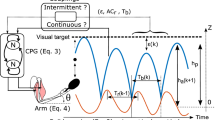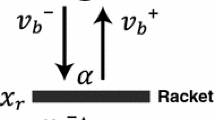Abstract
How do humans discover stable solutions to perceptual-motor tasks as they interact with the physical environment? We investigate this question using the task of rhythmically bouncing a ball on a racket, for which a passively stable solution is defined. Previously, it was shown that participants exploit this passive stability but can also actively stabilize bouncing under perceptual control. Using a virtual ball-bouncing display, we created new behavioral solutions for rhythmic bouncing by introducing a temporal delay (45°–180°) between the motion of the physical racket and that of the virtual racket. We then studied how participants searched for and realized a new solution. In all delay conditions, participants learned to maintain bouncing just outside the passively stable region, indicating a role for active stabilization. They recovered the approximate initial phase of ball impact in the virtual racket cycle (half-way through the upswing) by adjusting the impact phase with the physical racket. With short delays (45°, 90°), the impact phase quickly shifted later in the physical racket upswing. With long delays (135°, 180°), bouncing was destabilized and phase was widely visited before a new preferred phase gradually emerged, during the physical downswing. Destabilization was likely due to the loss of spatial symmetry between the ball and physical racket motion at impact. The results suggest that new behavioral solutions may be discovered and stabilized through broad irregular sampling of variable space rather than through a systematic search.







Similar content being viewed by others
Notes
The variability in the latency measurement is caused by an incompatibility between the Flock of Bird (120 Hz) and the video-projector (50 Hz) update rates, coupled with a lack of synchronization between the two components.
Instead of correcting the overall 37.3 m s end-to-end latency of our VE, we chose to correct only 8.3 m s with a predictive polynomial regression because this 8.33 m s predictive filter leads to the minimal error in the approximation of the physical racket positions and velocities (mean position error = 0.0005 ± 0.0013 m; mean velocity error = 0.2925 ± 0.1278 m s−1).
References
Adelstein BD, Johnston ER, Ellis SR (1996) Dynamic response of electromagnetic spatial displacement trackers. Presence Teleoper Virtual Environ 5: 302–318
Allison RS, Harris LR, Jenkin M, Jasiobedzka U, Zacher JE (2001) Tolerance of temporal delay in virtual environments. Virtual Reality 2001 conference (VR’01), Yokohama, pp 247–253, 17 March 2001
Bingham GP, Schmidt RC, Zaal FT (1999) Visual perception of the relative phasing of human limb movements. Percept Psychophys 61:246–258
Cole BJ (2002) Evolution of self-organized systems. Biol Bull 202:256–261
Cunningham DW, Billock VA, Tsou BH (2001) Sensorimotor adaptation to violations of temporal contiguity. Psychol Sci 12:532–535
Darwin C (1859) On the origin of species by means of natural selection, or the preservation of favoured races in the struggle for life. Murray, London
Dijkstra TMH, Katsumata H, de Rugy A, Sternad D (2004) The dialogue between data and model: passive stability and relaxation behavior in a ball-bouncing task. J Nonlin Stud 11(3):319
Eversheim U, Bock O (2001) Evidence for processing stages in skill acquisition: a dual-task study. Learn Mem 8:183–189
Foo P, Goldfield EC, Kay B, Warren WH (2004) The dynamics of infant bouncing: retrospect and prospect. In: Symposium at the International Society of Infancy Studies, Chicago
Foulkes AJ, Miall RC (2000) Adaptation to visual feedback delays in a human manual tracking task. Exp Brain Res 131:101–110
Gibson JJ (1979) The ecological aproach to visual perception. Lawrence Earlbaum Associates Inc., Boston
Gobbetti E, Scateni R (1998) Virtual reality: past, present and future. Stud Health Technol Inform 58:3–20
Holland JH (1992) Adaptation in natural and artificial systems. MIT Press, Cambridge
Kelso JAS (1981) On the oscillatory basis of movement. Bull Psychon Soc 18:63
Kelso JAS (1994) Informational Character of Self-Organized Coordination Dynamics. Hum Mov Sci 13:393–413
Kelso JAS (1995) Dynamic Patterns: The Self-Organization of Brain and Behavior. MIT Press, Cambridge, Mass
Kelso JAS, Fink PW, DeLaplain CR, Carson RG (2001) Haptic information stabilizes and destabilizes coordination dynamics. Proc Biol Sci 268:1207–1213
Langenberg U, Hefter H, Kessler KR, Cooke JD (1998) Sinusoidal forearm tracking with delayed visual feedback. I. Dependence of the tracking error on the relative delay. Exp Brain Res 118:161–170
Liu YT, Mayer-Kress G, Newell KM (2003) Beyond curve fitting: a dynamical systems account of exponential learning in a discrete timing task. J Mot Behav 35:197–207
Mechsner F, Kerzel D, Knoblich G, Prinz W (2001) Perceptual basis of bimanual coordination. Nature 414:69–73
Newell KM, van Emmerik REA, McDonald PV (1989) Search strategies and the acquisition of coordination. In: Wallace SA (ed) Perspectives on the coordination of movement. Martinus Nijhoff, Dordrecht, pp 85–122
Newell KM, McDonald MP, Kugler PN (1991) The perceptual-motor workspace and the acquisition of skill. In: Requin J, Stelmach GE (eds) Tutorials in motor neuroscience. Martinus Nijhoff, Dordrecht, pp 95–108
Newell KM, Liu YT, Mayer-Kress G (1997) The sequential structure of movement outcome in learning a discrete timing task. J Mot Behav 29:366–282
de Rugy A, Wei K, Muller H, Sternad D (2003) Actively tracking ‘passive’ stability in a ball bouncing task. Brain Res982:64–78
Saltzman E, Kelso JAS (1987) Skilled actions: a task-dynamic approach. Psychol Rev 94:84–106
Schaal S, Atkeson CG, Sternad D (1996) One-handed juggling: a dynamical approach to a rhythmic movement task. J Mot Behav 28:165–183
Schmidt RC, Carello C, Turvey MT (1990) Phase transitions and critical fluctuations in the visual coordination of rhythmic movements between people. J Exp Psychol Hum Percept Perform 16:227–247
Siegler I, Mantel B, Warren WH, Bardy B (2003) Behavioral dynamics of a rhythmic ball-bouncing task. Paper presented at the IV progress in motor control conference, Caen, France
Sternad D, Katsumata H (2000) The role of dynamic stability for the acquisition and performance of a rhythmic skill. In: Raczek J, Waskiewicz Z, Juras G (eds) Current research in motor control. Interaktiv SC, Katowice
Sternad D, Duarte M, Katsumata H, Schaal S (2001a) Bouncing a ball: tuning into dynamic stability. J Exp Psychol Hum Percept Perform 27:1163–1184
Sternad D, Duarte M, Katsumata H, Schaal S (2001b) Dynamics of a bouncing ball in human performance. Phys Rev E Stat Nonlin Soft Matter Phys 63:011902
Tass P, Kurths J, Rosenblum MG, Guasti G, Hefter H (1996) Delay-induced transitions in visually guided movements. Phys Rev E Stat Phys Plasma Fluids Related Interdiscip Topics 54:R2224–R2227
Warren WH (2006) The dynamics of perception and action. Psychol Rev 113:358–389
Welch RB (1978) Perceptual modification: adapting to virtual environment. Academic, New York
Wenzel EM (1998) The impact of system latency on dynamic performance in virtual acoustic environments. Proceedings of the 15th International Congress on Acoustics Meeting of the Acoustical Society of America, Seattle
Wilson AD, Bingham GP, Craig JC (2003) Proprioceptive perception of phase variability. J Exp Psychol Hum Percept Perform 29:1179–1190
Yamanishi J, Kawato M, Suzuki R (1980) Two coupled oscillators as a model for the coordinated finger tapping by both hands. Biol Cyber 37:219–225
Zaal FT, Bingham GP, Schmidt RC (2000) Visual perception of mean relative phase and phase variability. J Exp Psychol Hum Percept Perform 26:1209–1220
Zanone PG, Kelso JAS (1992) Evolution of behavioral attractors with learning: non-equilibrium phase transitions. J Exp Psychol Hum Percept Perform 18:403–421
Zanone PG, Kelso JAS (1997) Coordination dynamics of learning and transfer: collecive and component levels. J Exp Psychol Hum Percept Perform 23:1454–1480
Acknowledgments
Supported by the French Fond National pour la Science (IUF 2002:2006), and by Enactive Interfaces, a network of excellence (IST contract #002114) of the Commission of the European Community, with additional support from the University of Paris Sud 11 (BQR-RV-2003).
Author information
Authors and Affiliations
Corresponding author
Rights and permissions
About this article
Cite this article
Morice, A.H.P., Siegler, I.A., Bardy, B.G. et al. Learning new perception–action solutions in virtual ball bouncing. Exp Brain Res 181, 249–265 (2007). https://doi.org/10.1007/s00221-007-0924-1
Received:
Accepted:
Published:
Issue Date:
DOI: https://doi.org/10.1007/s00221-007-0924-1




